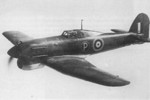Tornado
| Country | United Kingdom |
| Manufacturer | Hawker Aviation |
| Primary Role | Prototype Aircraft |
| Maiden Flight | 6 October 1939 |
Contributor: Alan Chanter
ww2dbaseOn April 22, 1938, Sydney Camm and his team at Hawker Aviation submitted two tenders to the British Air Ministry's specification F.18/37 for a single-seat interceptor. One was referred to as the "R-type" and the other as the "N-type". Both were to use fundamentally similar airframes but with different powerplants. F.18/37 had originated from a proposal and preliminary drawings which, in July 1937, Hawker had earlier proposed for a fighter powered by the newly developed Napier Sabre 24-cylinder horizontal-H engine - a powerplant which promised outputs in excess of 2,000 horsepower. Four months later, on August 30th, the Ministry ordered four prototypes - two with the Sabre engine and two with the Rolls Royce Vulture.
ww2dbaseStructurally, the Vulture-powered Type "R" (now named Tornado) and the Sabre-powered Type "N" were of similar construction; the front fuselage being of steel-tube with its aft portion of a stressed skin monocoque with all metal wings. Prototypes of both versions were commenced but it soon became evident that the Type "R" with its 1,760 h.p. 24-cylinder X-type Rolls Royce Vulture II - basically two 12-cylinder Peregrine V engines driving a common crankshaft - appeared the most promising venture and because the first of the two types to begin flight trials. This aircraft (P5219) made its maiden flight on 6 October, 1939, with Hawker test pilot P. G. Lucas at the controls. A similarly powered second prototype (P5224) was flown on 5 December 1940, which differed from the first primarily in having provision for a four 20-millimeter cannon armament.
ww2dbaseThe deterioration of the war situation in May 1940 led to the cancellation of further Tornado development in order to allow priority to be given to Hurricane fighter production, but in the following October, production was reinstated, and an assembly line established at the Woodford factory of A. V. Roe.
ww2dbaseThe prototypes' flight trials suggested that the production model would be better with the 1,980 hp, with Vulture V of which both prototypes were re-engined. The Vulture engine was soon found to suffer from various problems, particularly failures of connecting rod bolts, and as their Merlin engine possessed absolute priority, Rolls Royce was forced to abandon the production of this X-type engine. Hawker were then asked to put forward proposals for versions of the Tornado with alternative engines such as the Wright Duplex Cyclone Type C, the Bristol Centaurus or the Fairey Monarch, but after only one production example (R7936) had been completed the Air Ministry decided to abandon production the initial production batch of 201 Tornado aircraft commenced at the Woodford assembly line. R7936 made its first flight on 29 August, 1941, and was subsequently developed as a test bed for de Havilland and Rotol contraprops.
ww2dbaseIn February 1941, Hawker received approval for the completion of a third Tornado prototype (HG641) specifying it to be powered by a 2,210 hp Bristol Centaurus CE.4S 18-cylinder air cooled radial engine. This aircraft flew on 23 October 1941. The Centaurus engine initially had an exhaust collector ring forward from which a single external exhaust stack pipe led back under the root of the port wing. This was found to be not entirely satisfactory, and so the oil-cooler duct was enlarged and led forward to the nose, while twin exhaust pipes led back from the front collector ring through the fairing to eject under the belly of the fuselage. In tests the Centaurus powered prototype achieved a maximum speed of 402 miles per hour at 18,000 feet, a climb to 20,000 feet in 8.4 minutes, and reached a service ceiling of 32,800 feet. It was through trials with HG641 that Hawkers gained valuable information that they would employ in the development of their Centaurus-powered Hawker Tempest II (q.v.).
ww2dbaseSources:
William Green, War Planes of the Second World War Volume II (MacDonald, London, 1961)
William Green & Gordon Swinborough, The Complete Book of Fighters (Salamander Books, 1994)
Wikipedia
Last Major Revision: Jun 2016
Tornado Timeline
| 6 Oct 1939 | The Hawker Tornado aircraft took its first flight with test pilot P. G. Lucas at the controls. |
| 5 Dec 1940 | The second Tornado prototype aircraft took flight. |
| 31 Oct 1941 | The third Tornado prototype aircraft took flight with a 2,210-horsepower Bristol Centaurus 18-cylinder engine. |
SPECIFICATIONS
Tornado
| Machinery | One 1,980hp Rolls Royce Vulture V 24-cyl X-type liquid cooled engine |
| Armament | 12x0.303in Browning machine guns or 4x20mm British Hispano cannon |
| Crew | 1 |
| Span | 12.77 m |
| Length | 10.00 m |
| Height | 4.47 m |
| Wing Area | 26.29 m² |
| Weight, Empty | 3,800 kg |
| Weight, Loaded | 4,318 kg |
| Weight, Maximum | 4,839 kg |
| Speed, Maximum | 640 km/h |
| Service Ceiling | 10,640 m |
Photographs
 |  |  |
Please consider supporting us on Patreon. Even $1 per month will go a long way! Thank you. Please help us spread the word: Stay updated with WW2DB: |
- » US Government Plans to Purge WW2 Information (17 Mar 2025)
- » WW2DB's 20th Anniversary (29 Dec 2024)
- » Wreck of USS Edsall Found (14 Nov 2024)
- » See all news
- » 1,167 biographies
- » 337 events
- » 44,601 timeline entries
- » 1,243 ships
- » 350 aircraft models
- » 207 vehicle models
- » 376 weapon models
- » 123 historical documents
- » 261 facilities
- » 470 book reviews
- » 28,520 photos
- » 367 maps
Lt. Gen. Lewis B. "Chesty" Puller, at Guadalcanal
Please consider supporting us on Patreon. Even $1 a month will go a long way. Thank you!
Or, please support us by purchasing some WW2DB merchandise at TeeSpring, Thank you!